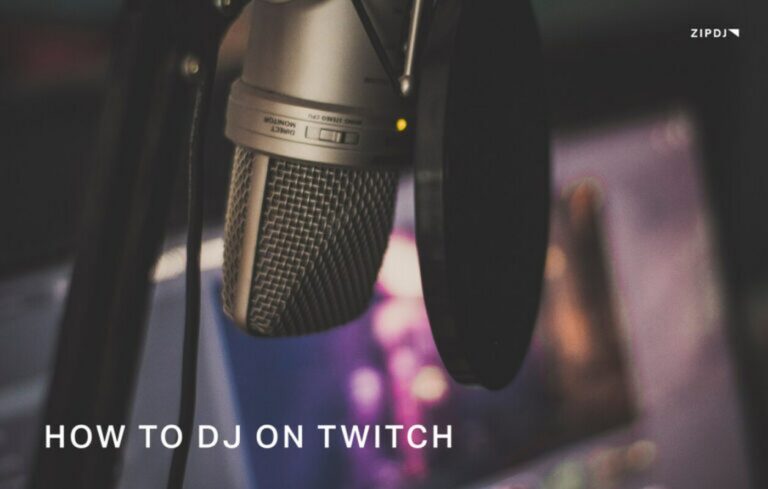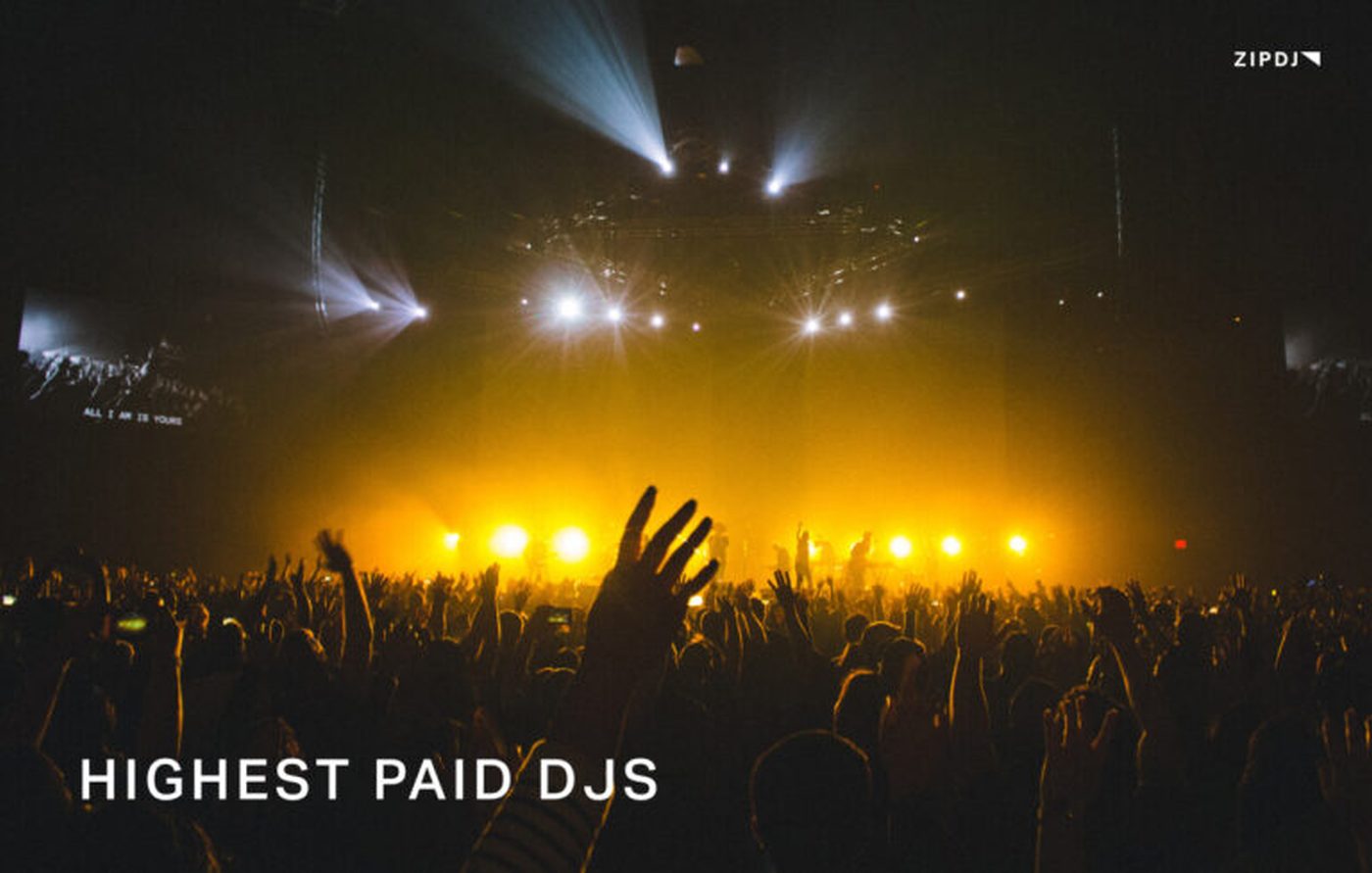How To DJ On Twitch: A Step-By-Step Guide

Learning how to DJ on Twitch is a great way to expand your online presence and show off your mixing skills to new fans.
With a basic setup and internet connection, aspiring DJs can stream on Twitch and help build their reputation within the online community.
Continue reading, and we’ll break down everything you need to know to DJ on Twitch, from the essential hardware and software required to handy tips to grow your audience.

How To DJ On Twitch (Step-By-Step)
Learning how to DJ on Twitch requires understanding the equipment and software needed to perform live streaming sets on their platform.
This guide will explore everything you need to know to get started, from choosing the right gear to learning the ins and outs of copyrighted materials.
We’ll also cover some of the frequently asked questions DJs have about DJing on a Twitch stream and how you can generate ad revenue from your live stream.
Why DJ On Twitch?
Twitch has long established a reputation as the place to go for live-streaming video games, but it’s also incredibly popular among DJs wanting to showcase their content.
With its growing user base, many DJs have turned to Twitch streams to perform their DJ sets and connect with their fan base.
This makes it ideal for those who want to build their DJ brand and host events, find creatives to collaborate with, and reach a new audience.
While streaming platforms such as Facebook, Instagram, and YouTube feature music detection tools to shut down streams that violate copyright, Twitch is designed around such content.
What You’ll Need To Stream On Twitch
Before you can begin DJing on Twitch, you’ll need to get your hands on the relevant hardware and DJ software required to stream on their platform.
This includes a computer or laptop, a web camera and microphone, and the relevant cables to connect your DJ controller or turntable to your computer.
You’ll also need a solid internet connection with a minimum 5Mbps upload speed, although 10Mbps is preferable (using an ethernet cable rather than WiFi is recommended.)
So, without further do, let’s explore the key steps you need to follow to stream your DJ set on Twitch:
Step 1: Create A Twitch Account
Once all your gear is set up, it’s time to sign up for a Twitch account. Choose your username and password and fill in your email address and date of birth.
Next, you’ll be asked to choose three or more interests, which Twitch will then use to push recommendations and help you to tailor your feed.
When choosing your username, match this to your DJ name and tie this into your other efforts to promote your music to keep your brand consistent across social media channels.
Step 2: Customize Your Channel
Once you’ve set up your account, you can begin to customize your channel, selecting the profile pictures and cover image that encapsulates your offer.
You can draw inspiration from some of the best DJ websites to see how established DJs define their brands, design your logos, or hire a professional designer to do this for you.
If you’ve already set up a website and social media channels, customize your Twitch channel with the same visual elements to keep this consistent across the board.
Step 3: Configure Your Audio Settings
Next, you’ll need to configure your settings to ensure you have a direct line from your DJ controller or mixer to your computer.
The last thing you want to do is use a mic input from your laptop as a port for your speakers since this will result in sub-par audio quality that deters potential listeners.
Twitch offers a range of configuration options in their settings to help you get set up correctly, accessed via the Audio Mixer link.
You can also use the Twitch Gear options to change your DJ audio source settings, including adding or removing audio delays, compressors, noise gates, and noise suppressors.
Step 4: Connect Your Hardware
Whether you’re using Pioneer’s Rekordbox, Traktor, or Serato DJ Pro, you’ll need to be able to connect your hardware to the Twitch platform.
The most common method DJs use for Twitch streaming is to use an audio interface, with companies such as Focusrite and Native Instruments among the most popular brands.
With a broad range of DJ controllers on the market, researching the best audio interface options for your specific setup is worthwhile to ensure full compatibility.
If you’re using a single or multi-camera setup for your Twitch stream, choose the ones that can be attached via USB to the computer used to stream your videos.
Step 5: Download Streaming Software
Various software options enable you to live stream your DJ sets, with Twitch Studio and Open Broadcaster Software being the most popular.
Both have pros and cons, so digging into each offer’s tools should be the first step when learning how to live stream your DJ sets for public consumption.
The basic features offered by Twitch Studio include an easy-to-use guided setup to make sure your hardware and software are correctly configured.
It also has customizable templates and simple integration with the Twitch community for alerts, notifications, activity feeds, and chat.
With OBS Studio, users can access a broader selection of tools and comprehensive settings for audio, video, streaming, and hotkeys.
There’s a steeper learning curve with OBS Studio, and as it’s built around open-source software, you can expect new features to be added in the future.

Step 6: Schedule & Promote Your Stream
The best live stream in the world means nothing without an audience, so you’ll need to schedule your stream in advance and take the time to promote it.
Whether you’re using your stream to get DJ gigs or just having fun, you’ll still want to draw in as big an audience as possible.
This means making the most of social media platforms such as TikTok, Twitter, and Facebook and posting it as an upcoming event fans can add to their diary.
Collaborating with other Twitch streamers and DJs and connecting with online influencers can further help you promote your upcoming live stream.
Hosting a giveaway is another great way to draw in viewers for your Twitch streaming activities and bring more subscribers to your channel.
Step 7: Plan Your Set In Advance
Streaming a live set leaves no room for error, so planning your set in advance is a must if you want to ensure everything goes smoothly.
This means knowing what tracks you’re going to play, practicing your DJ skills, and playing music, you’re familiar with so you know when to introduce transitions.
If you’re already proficient, you can use your live stream to show off the DJ techniques you’ve mastered and make your sets even more impressive.
Depending on how many cameras you use, you may want to plan which angles to use at specific points in your set to deliver the best coverage.
Step 8: Take Steps To Avoid Copyright Infringements
While Twitch is perhaps the most lenient live streaming platform for copyright infringement detection, it’s worth taking steps to avoid getting a strike.
Producers who play their own tracks own the copyright to their music, but most DJs will use copyrighted music from established artists.
Techniques used by DJs on other platforms include using sound manipulation tools to alter the track and making mashups of their favorite songs in advance.
You can also sign up for a DJ pool, where you can access an exceptional variety of music from many genres and use them legally on your live streams.
Step 9: Perform A Test Run
With many variables to consider when streaming on Twitch, conducting a test run before your stream is crucial to avoid embarrassment.
During a test run, you should pay attention to your internet connection and upload speed and ensure the audio input is coming through with a clear signal.
Make sure you’ve set your camera options to the best settings for excellent video quality, and if you’re using a green screen, check that the background footage is working correctly.
If there are any issues, you can run a speed test on your internet connection, switch your camera lens to one with a better angle, and make any other necessary refinements.
Step 10: Engage With Your Audience
With everything set up and ready to go, it’s time to perform your DJ set on a live Twitch stream in front of an audience.
This means paying attention to any comments the audience drops in the chat and interacting with them at opportune moments between mixes.
Twitch engagement is easier using a two-computer setup, with one used for DJing and the other for responding to messages and checking out the overall vibe.
If that sounds like it might be overwhelming, you can always bring on a second pair of hands to help you with engagement while you focus on your mixing skills.
Once your Twitch stream’s finished, read through the comments and take on board any praise and constructive criticism to help you improve your next performance.
FAQs About DJing On Twitch
We’ve explored the fundamentals of Twitch DJing and the core phases you’ll need to consider when setting up your live stream.
In case you still have any queries, here are answers to some of the most commonly asked questions about DJing on Twitch:
1. Are you allowed to DJ on Twitch?
With established artists and their associated record labels owning the copyright to their tracks, DJing on Twitch is technically illegal.
However, using music downloaded from a DJ pool such as ZIPDJ means you can use it for broadcasts and DJing without fear of running afoul of the law.
2. What music is not allowed on Twitch?
Any music you don’t have the rights to is officially not allowed to be played on Twitch, although, as we’ve outlined above, they don’t use algorithms for detecting such music.
However, their Terms of Service and Community Guidelines do make it clear you are not allowed to include music you don’t own on their platform.
You can seek permission from the rights holders and see if they will allow you to use specific music or use a DJ pool like ZIPDJ that covers you for public broadcasting.
3. Can I play Spotify on Twitch?
While it is technically possible to play tracks from Spotify on Twitch, the same issues around copyright apply here as from other online resources.
Again, seek the appropriate licenses and permissions before playing songs from Spotify to ensure you’re covered and won’t have your stream deleted.
You can also look into how to DJ with Spotify using the Spotify DJ mode, which offers limited mixing techniques but is ideal for bedroom DJs and birthday parties.
4. How much money do DJs make on Twitch?
There are various ways you can earn money from your Twitch streams, from using the platform to sell merchandise to signing up for the Twitch Partner affiliate program.
Some of the highest-paid DJs in the world supplement their income with live streams on Twitch, with streamers in the top 100 earning at least $30,000 per month.
While it shouldn’t be your sole source of revenue, it’s certainly an additional option for earning money as a professional DJ.
Summary
That concludes this step-by-step guide exploring everything you need to know to start DJing on Twitch.
The most successful Twitch DJs can earn vast sums of money for their live mixes, engaging with their audience and extending their fan base worldwide.
Once you’ve mastered the basics, you can take your Twitch streams to the next level and introduce eye-catching visuals and effects.
Gain access to a massive archive of awesome music when you sign up to ZIPDJ and create exciting and original mixes on Twitch.
Not a member ?
Join Today for Unlimited Music Downloads. Visit zipdj.com for more information.



